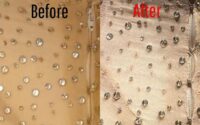Bad hair day? Blame your genes, new study says
Your bad hair day could be written in your DNA.
Genetic variations could be to blame for your wicked bed head, a new study found, as researchers discover more about the role genes play in hair patterns.
The study, published in the Journal of Investigative Dermatology, explored the phenomenon of hair whorls — circular patterns of hair dictated by hair follicle positioning — in more than 4,000 Chinese people.
Traditionally, hair whorls are categorized by a whorl number, single or double, as well as direction, whether they swirl clockwise or counterclockwise.
Because some atypical hair whorls were previously observed in those with “abnormal neurological development,” the researchers believed whorl patterns could be linked to genetics.

“We know very little about why we look like we do,” lead author Dr. Sijia Wang, from the Shanghai Institute of Nutrition and Health, Chinese Academy of Sciences, said in a statement.
“Our group has been looking for the genes underlying various interesting traits of physical appearance, including fingerprint patterns, eyebrow thickness, earlobe shape and hair curliness. Hair whorl is one of the traits that we were curious about.”
While it was widely believed that hair whorl patterns were inherited through a single gene, Wang said, the team’s research bore another possibility — that the whorl directions are “influenced by the cumulative effects of multiple genes.”

The report marks the first genome-wide association study on human hair whorls, analyzing the scalps of 2,149 Chinese people in the National Survey of Physical Traits cohort. It was later replicated on an additional 1,950 people in the Taizhou Longitudinal Study cohort.
Researchers identified four genetic variants they believe are responsible for hair whorl patterns.
“While previous work proposed the hypothesis of associations between hair whorl patterns and abnormal neurological development, no significant genetic associations were observed between hair whorl direction and behavioral, cognitive, or neurological phenotypes,” Wang said.
“Although we still know very little about why we look like we do, we are confident that curiosity will eventually drive us to the answers.”

For decades, a small percentage of the human genome remained a mystery.
The Human Genome Project successfully mapped 92% of one genome in 2003, but at the time, there was no way to verify the findings.
Last year, scientists were finally able to code a human genome in its entirety — building on the discoveries made two decades prior while correcting mistakes and filling gaps.
Then, in May, researchers published a draft of a “pangenome” comprised of DNA from 47 people from nearly every continent to better understand human diversity. Humans are 99.9% identical in their genetic makeup, with diversity found in that remaining 0.1%.
Scientists hope to expand the “pangenome” to 350 individuals by next year, according to CNN.
“Having a high quality human pangenome reference that increasingly reflects the diversity of the human population will enable scientists and healthcare professionals to better understand how genomic variants influence health and disease, and move us towards a future in which genomic medicine benefits everyone,” said Dr. Eric Green, the director of the US National Human Genome Research Institute.


